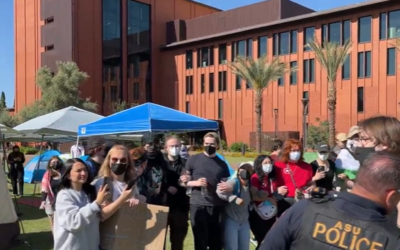By Corinne Murdock |
State Rep. Alex Kolodin (R-LD03) is urging the Arizona Senate to do away with a bill allowing the export of the Valley’s emergency water reserve.
The bill, HB2201 sponsored by State Rep. Tim Dunn (R-LD25), passed the House with bipartisan support, 33-23, on Monday. Kolodin said that such a measure would inevitably raise utility bills.
“HB2201 allows part of Scottsdale’s emergency water supply to be transferred to out-of-county users, raising our utility bills,” said Kolodin. “I voted no. Needs to die in the Senate!”
Kolodin told AZ Free News that HB2201 will serve as a detriment to suburban ratepayers and force cities to compete for the dwindling supply.
HB2201 enables the interbasin transport of cities’ emergency groundwater supply from within the Harquahala Irrigation Non-expansion Area (INA) to any location within La Paz County. Dunn explained during last month’s hearing on the matter in the Natural Resources, Energy, & Water Committee that the bill would allow La Paz County to grow their existing water resources.
The Harquahala INA covers approximately 766 square miles within La Paz and Maricopa counties in the west-central portion of the state. Currently, Harquahala INA water supply may only be withdrawn and transported by the state and political subdivisions to the following initial Active Management Areas (AMAs): Phoenix, Tucson, Santa Cruz, Pinal, and Prescott.
AMAs rely heavily on mined groundwater and therefore come with higher levels of management than INAs. INAs regulate wells in rural farming areas where groundwater overdraft — the removal of too much water — is less severe. There are two other INAs in the state: Hualapai Valley and Joseph City.
These distinctions are outlined by Arizona’s Groundwater Management Act (GMA), passed over 40 years ago, which restricts interbasin water transportation for the state’s 51 groundwater basins in order to ensure AMAs maintain a 100-year water supply, also known as an assured water supply.
Healthy interbasin water transport hinges on a concept known as safe-yield: ensuring a safe balance between groundwater withdrawals and the natural and artificial recharging of water to AMA aquifers. Overdrafting can damage aquifer structure and limit future water storing capacity, increase the costs of drilling and pumping, and reduce the water quality.
Harquahala INA is considered an emergency savings account of sorts for water, saved in the event of prolonged drought: no groundwater has been transported out of the basin since 1990, according to the latest report from the Arizona Department of Water Resources (ADWR), the authority on water management. Yet, ADWR also reported that in almost all years from 2004-2022, the Harquahala INA had more water leaving the basin than entering mainly due to agriculture, which have made up 98 percent of the INA’s demand.
ADWR projected that annual supply would be insufficient for annual demand under any projected scenario over the next 50 years.
Corinne Murdock is a reporter for AZ Free News. Follow her latest on Twitter, or email tips to corinne@azfreenews.com.








